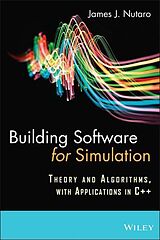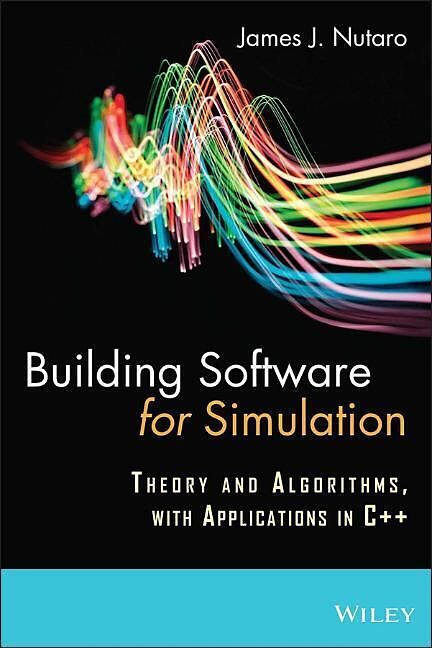Building Software for Simulation
Einband:
Fester Einband
EAN:
9780470414699
Untertitel:
Theory and Algorithms, with Applications in C++
Genre:
Elektrotechnik
Autor:
James J. Nutaro
Herausgeber:
Wiley
Auflage:
1. Auflage
Anzahl Seiten:
360
Erscheinungsdatum:
03.12.2010
ISBN:
978-0-470-41469-9
Informationen zum Autor JAMES J. NUTARO, PhD, is an adjunct faculty member at the University of Tennessee in Knoxville and a member of the research staff at Oak Ridge National Laboratory. He has developed simulation software used by industrial, academic, and research organizations including Raytheon, Northrop Grumman, Intel, and several universities. Nutaro has published articles on modeling and simulation in ACM and IEEE journals. He is Associate Editor for SIMULATION: Transactions of the Society for Computer Simulation International as well as for ACM Transactions on Modeling and Computer Simulation, and is a member of the IEEE. Klappentext A unique guide to the design and implementation of simulation softwareThis book offers a concise introduction to the art of building simulation software, collecting the most important concepts and algorithms in one place. Written for both individuals new to the field of modeling and simulation as well as experienced practitioners, this guide explains the design and implementation of simulation software used in the engineering of large systems while presenting the relevant mathematical elements, concept discussions, and code development.The book approaches the topic from the perspective of Zeigler's theory of modeling and simulation, introducing the theory's fundamental concepts and showing how to apply them to engineering problems. Readers will learn five necessary skills for building simulations of complicated systems:* Working with fundamental abstractions for simulating dynamic systems* Developing basic simulation algorithms for continuous and discrete event models* Combining continuous and discrete event simulations into a coherent whole* Applying strategies for testing a simulation* Understanding the theoretical foundations of the modeling constructs and simulation algorithmsThe central chapters of the book introduce, explain, and demonstrate the elements of the theory that are most important for building simulation tools. They are bracketed by applications to robotics, control and communications, and electric power systems; these comprehensive examples clearly illustrate how the concepts and algorithms are put to use. Readers will explore the design of object-oriented simulation programs, simulation using multi-core processors, and the integration of simulators into larger software systems.The focus on software makes this book particularly useful for computer science and computer engineering courses in simulation that focus on building simulators. It is indispensable reading for undergraduate and graduate students studying modeling and simulation, as well as for practicing scientists and engineers involved in the development of simulation tools. Zusammenfassung A unique guide to the design and implementation of simulation softwareThis book offers a concise introduction to the art of building simulation software, collecting the most important concepts and algorithms in one place. Written for both individuals new to the field of modeling and simulation as well as experienced practitioners, this guide explains the design and implementation of simulation software used in the engineering of large systems while presenting the relevant mathematical elements, concept discussions, and code development.The book approaches the topic from the perspective of Zeigler's theory of modeling and simulation, introducing the theory's fundamental concepts and showing how to apply them to engineering problems. Readers will learn five necessary skills for building simulations of complicated systems:* Working with fundamental abstractions for simulating dynamic systems* Developing basic simulation algorithms for continuous and discrete event models* Combining continuous and discrete event simulations into a coherent whole* Applying strategies for testing a simulation* Understanding the theoretical foundations of the modeling constructs and simulation alg...
Autorentext
JAMES J. NUTARO, PhD, is an adjunct faculty member at the University of Tennessee in Knoxville and a member of the research staff at Oak Ridge National Laboratory. He has developed simulation software used by industrial, academic, and research organizations including Raytheon, Northrop Grumman, Intel, and several universities. Nutaro has published articles on modeling and simulation in ACM and IEEE journals. He is Associate Editor for SIMULATION: Transactions of the Society for Computer Simulation International as well as for ACM Transactions on Modeling and Computer Simulation, and is a member of the IEEE.
Klappentext
A unique guide to the design and implementation of simulation software This book offers a concise introduction to the art of building simulation software, collecting the most important concepts and algorithms in one place. Written for both individuals new to the field of modeling and simulation as well as experienced practitioners, this guide explains the design and implementation of simulation software used in the engineering of large systems while presenting the relevant mathematical elements, concept discussions, and code development. The book approaches the topic from the perspective of Zeigler's theory of modeling and simulation, introducing the theory's fundamental concepts and showing how to apply them to engineering problems. Readers will learn five necessary skills for building simulations of complicated systems: * Working with fundamental abstractions for simulating dynamic systems * Developing basic simulation algorithms for continuous and discrete event models * Combining continuous and discrete event simulations into a coherent whole * Applying strategies for testing a simulation * Understanding the theoretical foundations of the modeling constructs and simulation algorithms The central chapters of the book introduce, explain, and demonstrate the elements of the theory that are most important for building simulation tools. They are bracketed by applications to robotics, control and communications, and electric power systems; these comprehensive examples clearly illustrate how the concepts and algorithms are put to use. Readers will explore the design of object-oriented simulation programs, simulation using multi-core processors, and the integration of simulators into larger software systems. The focus on software makes this book particularly useful for computer science and computer engineering courses in simulation that focus on building simulators. It is indispensable reading for undergraduate and graduate students studying modeling and simulation, as well as for practicing scientists and engineers involved in the development of simulation tools.
Inhalt
PREFACE. 1 INTRODUCTION. 1.1 Elements of a Software Architecture. 1.2 Systems Concepts as an Architectural Foundation. 1.3 Summary. 1.4 Organization of the Book. 2 FIRST EXAMPLE: SIMULATING A ROBOTIC TANK. 2.1 Functional Modeling. 2.2 A Robotic Tank. 2.2.1 Equations of Motion. 2.2.2 Motors, Gearbox, and Tracks. 2.2.3 Complete Model of the Tank's Continuous Dynamics. 2.2.4 The Computer. 2.2.5 Complete Model of the Tank. 2.3 Design of the Tank Simulator. 2.4 Experiments. 2.5 Summary. 3 DISCRETE-TIME SYSTEMS. 3.1 Atomic Models. 3.1.1 Trajectories. 3.1.2 The State Transition and Output Function. 3.1.3 Two Examples of Atomic, Discrete-Time Models. 3.1.4 Systems with Bags for Input and Output. 3.1.5 A Simulator for Atomic Models. 3.2 Network Models. 3.2.1 The Parts of a Network Model. 3.2.2 The Resultant of a Network Model. 3.2.3 An Example of a Network Model and Its Resultant. 3.2.4 Simulating the Resultant. 3.3 A Simulator for Discrete-Time Systems. 3.4 Mealy/Moore-Type Systems. 3.5 Cellular Automata. 3.6 Summary. 4 DISCRETE-EVENT SYSTEMS. 4.1 Atomic Models. 4.1.1 Time and Trajectories. 4.1.2 The State Transition Function. 4.1.3 The Output Function. 4.1.4 Legitimate Systems. 4.1.5 An Example of an Atomic Model. 4.1.6 T…

Leider konnten wir für diesen Artikel keine Preise ermitteln ...
billigbuch.ch sucht jetzt für Sie die besten Angebote ...
Die aktuellen Verkaufspreise von 6 Onlineshops werden in Realtime abgefragt.
Sie können das gewünschte Produkt anschliessend direkt beim Anbieter Ihrer Wahl bestellen.
Loading...
Die aktuellen Verkaufspreise von 6 Onlineshops werden in Realtime abgefragt.
Sie können das gewünschte Produkt anschliessend direkt beim Anbieter Ihrer Wahl bestellen.
| # | Onlineshop | Preis CHF | Versand CHF | Total CHF | ||
|---|---|---|---|---|---|---|
| 1 | Seller | 0.00 | 0.00 | 0.00 |
